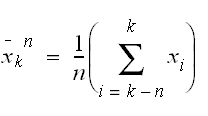Filter_MovingAverage Function Block
This figure shows the pin diagram of the Filter_MovingAverage function block:

The Filter_MovingAverage function block calculates the moving average value for the user-defined number of input samples.
When the number of recorded samples are:
oLess than the specified value i_uiSmplCnt, the function block calculates the average value with the available number of inputs and gives the corresponding output.
oEqual to or greater than the specified value i_uiSmplCnt, the function block calculates the average value with i_uiSmplCnt number of inputs and gives the corresponding output. It operates like the moving average filter.
oFor i_uiSmplCnt = 0, the input value is assigned to output.
Number of Samples to average (i_uiSmplCnt) = 3:
|
Scan Cycle |
Input Value (i_rIput) |
Output Value (q_rOput) |
|---|---|---|
|
1 |
2.0 |
2.0 |
|
2 |
3.0 |
2.5 |
|
3 |
4.0 |
3.0 |
|
4 |
2.0 |
3.0 |
|
5 |
1.5 |
2.5 |
|
6 |
4.0 |
2.5 |
This figure shows normal behavior:

This equation shows the generalized equation for the Filter_MovingAverage function:

n = Number of samples,
xi = Input samples,
k = GPL.Gc_uiMaxAvgeSmpl, internal constant,
 = Calculated output.
= Calculated output.
In the event of a decrease in the number of sample counts (i_uiSmplCnt), the output (q_rOput) in the consequent scans is calculated by decreasing the number of samples by one in every consecutive scan.
Invalid parameter such as i_uiSmplCnt > GPL.Gc_uiMaxAvgeSmpl results in detected error and corresponding detected error ID is generated.
During the detected error state, the output is set to zero.
Detected error can be reset only through the rising edge of i_xErrRst input.
As shown in behavior of output figure above, q_xBusy is TRUE whenever the function block is enabled and when there is no detected error.